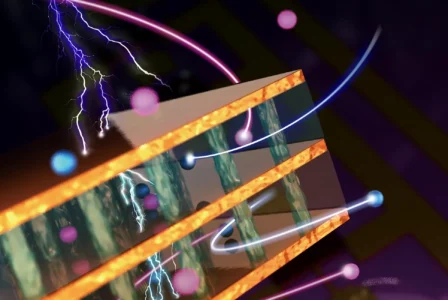
An international research team from China’s Northwestern University has created an electrochemical transistor that conducts both conventional electricity and ions. It is blood, sweat and outdoor resistant. The development is based on a new type of electronic polymer and vertical rather than flat architecture. The field of application of the novelty is electronics, bioelectronics and medicine. The transistor is characterized by high performance, lightness and flexibility.
The new transistor has the ability to amplify significant signals, making it very useful for biomedical sensing. It will allow the development of wearable devices that can perform signal processing in situ – right in the biotechnological environment. Potential applications include monitoring heart rate, blood sodium and potassium levels, and tracking eye movements to study sleep disorders.
“All modern electronics use transistors that quickly turn current on and off,” said Tobin J. Marks, co-author of the study. “Here we use chemistry to improve switching. Our electrochemical transistor takes performance to a new level. You have all the properties of a conventional transistor, but much higher gain, ultra-stable cyclic switching, small dimensions that can provide high-density integration, and easy and cheap manufacturing.”
Vertical electrochemical transistor based on a new polymer material. The development and synthesis of materials, as well as the fabrication and characterization of transistors, required the collaboration of chemists, materials scientists, biomedical scientists, and engineers from around the world.
Tobin J. Marks, a world leader in materials science and organic electronics and Professor of Catalytic Chemistry in the Weinberg College of Arts and Sciences, led the research team with Antonio Facchetti, Weinberg Professor of Chemistry. Wei Huang, a professor at the University of Electronic Science and Technology of China, Jonathan Rivney, a professor of biomedical engineering at the McCormick School, and 17 other scientists participated in the development.
“This exciting new type of transistor allows us to talk [одновременно] in the language of biological systems, which often communicate with the help of ions, and electronic systems,” Professor Rivnoy explains. “The ability of transistors to work very efficiently as mixed conductors makes them attractive for bioelectronic diagnostics and therapy.”
“Thanks to the vertical architecture, our electrochemical transistors can be stacked on top of each other,” says Professor Facchetti. Thus, we can create very dense electrochemical complementary circuits, which is impossible for conventional planar electrochemical transistors.
To create more reliable and powerful electronic circuits, two types of transistors are needed: p-type transistors, which carry a positive charge, and n-type transistors, which carry a negative charge. Chains, which of them, are called complimentary. A problem researchers have faced in the past is that n-type transistors are difficult to manufacture and tend to be unstable.
This is the first work demonstrating electrochemical transistors of both types (p+n) with similar and very high performance, leading to efficient electrochemical complementary circuits.
The study “Vertical organic electrochemical transistors for complementary circuits” detailing the efficient electrochemical transistor and accompanying article was recently published in the journal Nature.
10 times more light: the use of titanium dioxide in laser LEDs increases the intensity of radiation – Kyoto University research
Source: SciTechDaily




